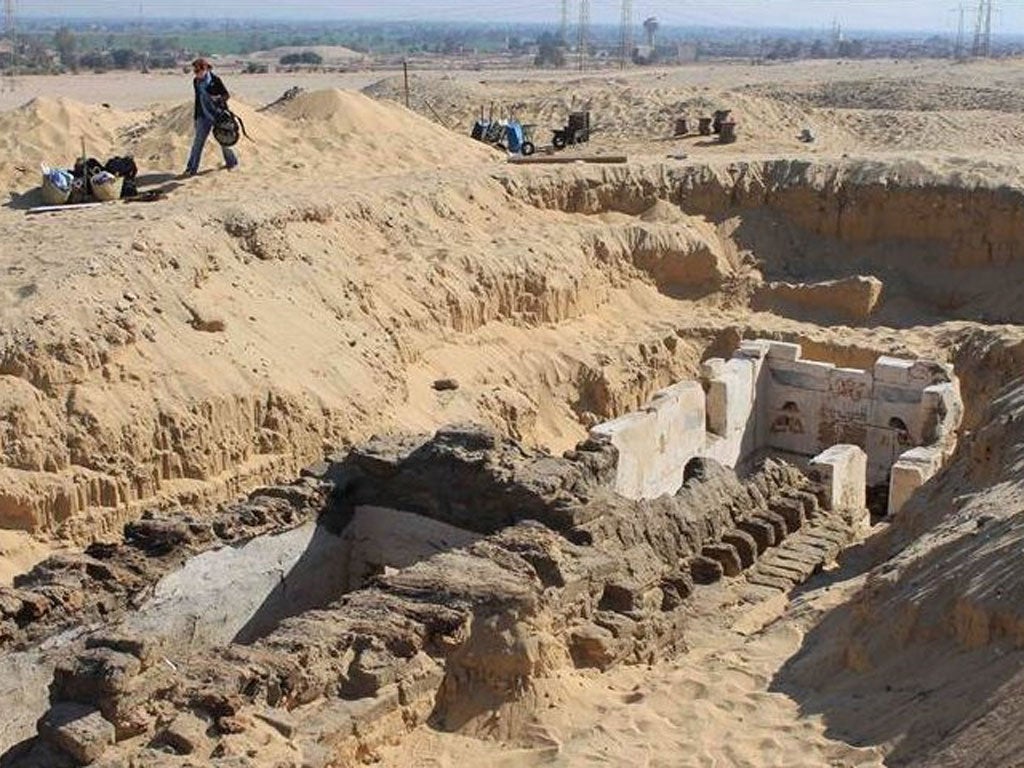Valley of the other kings: Lost dynasty found in Egypt
Archaeologists have unearthed an ancient cemetery thought to contain the tombs of 16 pharaohs

A previously unknown, yet potentially very important, ancient Egyptian kingdom has been discovered by archaeologists working in the Nile Valley.
Excavations at Abydos, 70 miles north-west of Egypt's famous Valley of the Kings, have revealed the existence of an entire royal cemetery, now believed to be the final resting place of up to 16 mysterious pharaohs - an entire dynasty whose existence was up till now virtually unknown to the Egyptological world.
Bizarrely more than a century ago, in 1901-1902, a British team, led by the famous Egyptologist, Flinders Petrie, entered four of the tombs - but had no idea as to who they belonged to or even of their high-status. Ironically, the vital inscription revealing the existence of the lost kingdom and indicating the cemetery's royal status, was in a tomb buried deep under the desert sand less than 20 metres from where they were digging. Almost a century later, in 1997, a Danish Egyptologist, Dr Kim Ryholt, deduced from a highly damaged ancient Egyptian papyrus, that a lost dynasty should theoretically have existed at Abydos between 1650 BC and 1600 BC - part of an era of political disunity known in Ancient Egyptian history as the Second Intermediate Period.
But there was no proof until the last few weeks when a team of American Egyptologists discovered a previously unknown tomb buried under three metres of sand. On entering it and illuminating its wall paintings for the first time in literally thousands of years, they deciphered a painted inscription which revealed the name and titles of an unknown pharaoh - the first physical proof that the mysterious lost kingdom and its ruling dynasty had actually existed.
The previously unknown ancient Egyptian ruler's name was Senebkay - a spiritually-sounding composite word meaning 'my soul is healthy'.
The tomb's contents had been badly damaged by tomb robbers more than 2000 years ago, but the American Egyptologists, from the University of Pennsylvania , succeeded in piecing together some of the grave goods - and the lost pharaoh's physical remains which had been scattered across the tomb's floor when the robbers ripped his mummy apart in search of gold. The Egyptologists have now almost completely re-assembled his skeleton.
The pharaoh was 1.75 metres tall (quite substantial in ancient Egyptian terms) and died aged around 50 of unknown causes. Because two key hieroglyphic characters from his very long official throne name (quite different from his short birth name, Senebkay) survived in the damaged papyrus, studied by the Danish Egyptologist back in the 1990s, the American excavators at the site had been able to deduce that Senebkay was either the first or the second pharaoh in the lost dynasty.
The evidence in the papyrus - part of a globally important collection in Turin's Egyptian Museum - suggests the possibility that there were 16 pharaohs in the dynasty.
So far, the University of Pennsylvania team has either physically located, or have detected through geophysical techniques, ten of those tombs. Of those, six have now been entered and explored by the team. Four of those six had unfortunately been almost entirely emptied by tomb robbers millennia ago - but the fifth yielded the skeletal remains of Senebkay, his fragmentary coffin, his funerary mask and his canopic chest (to house his mummified internal organs).
A sixth tomb contained a vast royal stone sarcophagus which had been used to house another pharaoh of the lost dynasty - possibly Senebkay's immediate predecessor or successor whose name is as yet unknown.
The 60 tonne red quartzite sarcophagus had actually been 'stolen' from a tomb of an earlier Egyptian pharaoh (Sobekhotep I of the ancient Egyptian Middle Kingdom's 13th dynasty) and recycled as a suitably grand final resting place for the so far nameless lost dynasty pharaoh.
The American Egyptological team, working in conjunction with Egypt's Ministry of Antiquities - also believes that Senebkay's canopic chest and probably other items were also recycled from the tomb of earlier pharaohs.
“The re-use of material probably reflects the relative economic weakness of the lost dynasty,” says Egyptologist, Dr. Josef Wegner, of the university's Penn Museum.
Now, using geophysical equipment to 'x-ray' the ground, the team is hoping to discover more royal tombs from the lost dynasty and to find more inscriptions identifying the other kings of that dynasty.
As the new information mounts up, they expect to begin to unravel one of the key geo-political mysteries of the ancient world - how exactly did Egypt's famous New Kingdom come to be established after some 150 years of disunity and partial foreign occupation. The north of Egypt had been occupied by peoples from what are now Syria, Lebanon and Israel.
In around 1550 BC, after at least 50 years of war, the southern kingdom defeated the foreign-originating dynasty in the north and succeeded in re-uniting Egypt. However the new archaeological discovery at Abydos now shows definitively that there was a previously unknown third state (the' Kingdom of Abydos'), ruled by the lost dynasty, which existed for a time between the native Egyptian south and the foreign-occupied north. It may have served as a sort of buffer state (controlling 100 to 150 mile stretch of the Nile Valley) - and its demise in around 1600 seems to roughly coincide with the beginning of the native South's struggle to liberate the North from foreign rule.
The excavators now realize that events leading up to the creation of the New Kingdom (the Egyptian state associated with famous pharaohs like Ramesses and Tutankhamun) probably somehow involved the lost kingdom and its dynasty and would therefore have been even more complex than previously thought.
Subscribe to Independent Premium to bookmark this article
Want to bookmark your favourite articles and stories to read or reference later? Start your Independent Premium subscription today.

Join our commenting forum
Join thought-provoking conversations, follow other Independent readers and see their replies